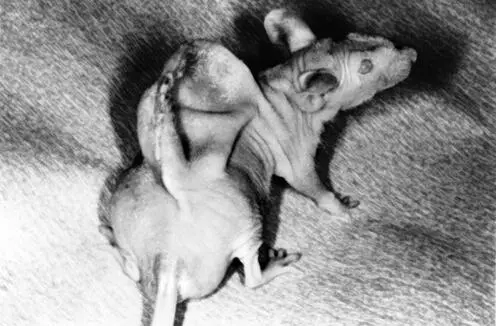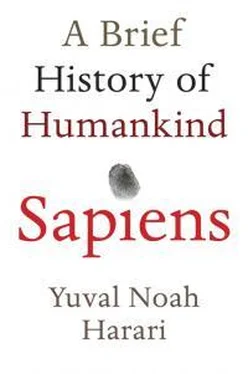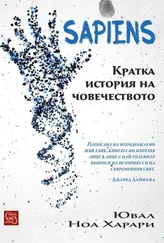There is nothing new about biological engineering, per se. People have been using it for millennia in order to reshape themselves and other organisms. A simple example is castration. Humans have been castrating bulls for perhaps 10,000 years in order to create oxen. Oxen are less aggressive, and are thus easier to train to pull ploughs. Humans also castrated their own young males to create soprano singers with enchanting voices and eunuchs who could safely be entrusted with overseeing the sultans harem.
But recent advances in our understanding of how organisms work, down to the cellular and nuclear levels, have opened up previously unimaginable possibilities. For instance, we can today not merely castrate a man, but also change his sex through surgical and hormonal treatments. But that’s not all. Consider the surprise, disgust and consternation that ensued when, in 1996, the following photograph appeared in newspapers and on television:

46. A mouse on whose back scientists grew an ‘ear’ made of cattle cartilage cells. It is an eerie echo of the lion-man statue from the Stadel Cave. Thirty thousand years ago, humans were already fantasising about combining different species. Today, they can actually produce such chimeras.
No, Photoshop was not involved. It’s an untouched photo of a real mouse on whose back scientists implanted cattle cartilage cells. The scientists were able to control the growth of the new tissue, shaping it in this case into something that looks like a human ear. The process may soon enable scientists to manufacture artificial ears, which could then be implanted in humans. 1
Even more remarkable wonders can be performed with genetic engineering, which is why it raises a host of ethical, political and ideological issues. And it’s not just pious monotheists who object that man should not usurp God’s role. Many confirmed atheists are no less shocked by the idea that scientists are stepping into nature’s shoes. Animal-rights activists decry the suffering caused to lab animals in genetic engineering experiments, and to the farmyard animals that are engineered in complete disregard of their needs and desires. Human-rights activists are afraid that genetic engineering might be used to create supermen who will make serfs of the rest of us. Jeremiahs offer apocalyptic visions of bio-dictatorships that will clone fearless soldiers and obedient workers. The prevailing feeling is that too many opportunities are opening too quickly and that our ability to modify genes is outpacing our capacity for making wise and far-sighted use of the skill.
The result is that we’re at present using only a fraction of the potential of genetic engineering. Most of the organisms now being engineered are those with the weakest political lobbies – plants, fungi, bacteria and insects. For example, lines of E. coli, a bacterium that lives symbiotically in the human gut (and which makes headlines when it gets out of the gut and causes deadly infections), have been genetically engineered to produce biofuel. 2E. coli and several species of fungi have also been engineered to produce insulin, thereby lowering the cost of diabetes treatment. 3A gene extracted from an Arctic fish has been inserted into potatoes, making the plants more frost-resistant. 4
A few mammals have also been subject to genetic engineering. Every year the dairy industry suffers billions of dollars in damages due to mastitis, a disease that strikes dairy-cow udders. Scientists are currently experimenting with genetically engineered cows whose milk contains lysostaphin, a biochemical that attacks the bacteria responsible for the disease. 5The pork industry, which has suffered from falling sales because consumers are wary of the unhealthy fats in ham and bacon, has hopes for a still-experimental line of pigs implanted with genetic material from a worm. The new genes cause the pigs to turn bad omega 6 fatty acid into its healthy cousin, omega 3. 6
The next generation of genetic engineering will make pigs with good fat look like child’s play. Geneticists have managed not merely to extend sixfold the average life expectancy of worms, but also to engineer genius mice that display much-improved memory and learning skills. 7Voles are small, stout rodents resembling mice, and most varieties of voles are promiscuous. But there is one species in which boy and girl voles form lasting and monogamous relationships. Geneticists claim to have isolated the genes responsible for vole monogamy. If the addition of a gene can turn a vole Don Juan into a loyal and loving husband, are we far off from being able to genetically engineer not only the individual abilities of rodents (and humans), but also their social structures? 8
The Return of the Neanderthals
But geneticists do not only want to transform living lineages. They aim to revive extinct creatures as well. And not just dinosaurs, as in Jurassic Park . A team of Russian, Japanese and Korean scientists has recently mapped the genome of ancient mammoths, found frozen in the Siberian ice. They now plan to take a fertilised egg-cell of a present-day elephant, replace the elephantine DNA with a reconstructed mammoth DNA, and implant the egg in the womb of an elephant. After about twenty-two months, they expect the first mammoth in 5,000 years to be born. 9
But why stop at mammoths? Professor George Church of Harvard University recently suggested that, with the completion of the Neanderthal Genome Project, we can now implant reconstructed Neanderthal DNA into a Sapiens ovum, thus producing the first Neanderthal child in 30,000 years. Church claimed that he could do the job for a paltry $30 million. Several women have already volunteered to serve as surrogate mothers. 10
What do we need Neanderthals for? Some argue that if we could study live Neanderthals, we could answer some of the most nagging questions about the origins and uniqueness of Homo sapiens . By comparing a Neanderthal to a Homo sapiens brain, and mapping out where their structures differ, perhaps we could identify what biological change produced consciousness as we experience it. There’s an ethical reason, too – some have argued that if Homo sapiens was responsible for the extinction of the Neanderthals, it has a moral duty to resurrect them. And having some Neanderthals around might be useful. Lots of industrialists would be glad to pay one Neanderthal to do the menial work of two Sapiens.
But why stop even at Neanderthals? Why not go back to God’s drawing board and design a better Sapiens? The abilities, needs and desires of Homo sapiens have a genetic basis, and the Sapiens genome is no more complex than that of voles and mice. (The mouse genome contains about 2.5 billion nucleobases, the Sapiens genome about 2.9 billion bases – meaning the latter is only 14 per cent larger.) 11In the medium range – perhaps in a few decades – genetic engineering and other forms of biological engineering might enable us to make far-reaching alterations not only to our physiology, immune system and life expectancy, but also to our intellectual and emotional capacities. If genetic engineering can create genius mice, why not genius humans? If it can create monogamous voles, why not humans hard-wired to remain faithful to their partners?
The Cognitive Revolution that turned Homo sapiens from an insignificant ape into the master of the world did not require any noticeable change in physiology or even in the size and external shape of the Sapiens brain. It apparently involved no more than a few small changes to internal brain structure. Perhaps another small change would be enough to ignite a Second Cognitive Revolution, create a completely new type of consciousness, and transform Homo sapiens into something altogether different.
Читать дальше




![Юваль Ной Харари - Sapiens. Краткая история человечества [litres]](/books/34310/yuval-noj-harari-sapiens-kratkaya-istoriya-cheloveche-thumb.webp)





![Юваль Ной Харари - 21 урок для XXI века [Версия с комментированными отличиями перевода]](/books/412481/yuval-noj-harari-21-urok-dlya-xxi-veka-versiya-s-ko-thumb.webp)


